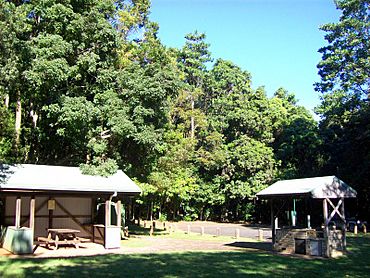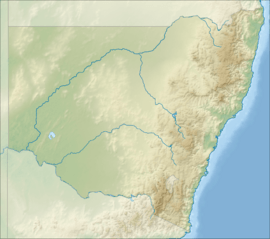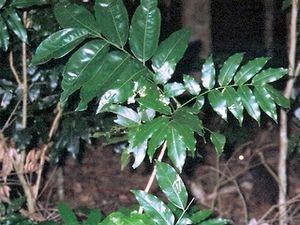Victoria Park Nature Reserve facts for kids
Quick facts for kids Victoria Park Nature ReserveNew South Wales |
|
|---|---|
|
IUCN Category IV (Habitat/Species Management Area)
|
|

A picnic area located in the reserve
|
|
| Nearest town or city | Alstonville |
| Established | April 1975 |
| Area | 0.18 km2 (0.1 sq mi) |
| Managing authorities | NSW National Parks and Wildlife Service |
| Website | Victoria Park Nature Reserve |
| See also | Protected areas of New South Wales |
The Victoria Park Nature Reserve is a special protected area in New South Wales, Australia. It is located in the Northern Rivers region. This reserve is a small piece of subtropical rainforest. It sits on a flat area that gets a lot of rain, close to the town of Alstonville.
The soil here is reddish-brown. It comes from basalt rock that flowed from nearby Mount Warning a long time ago. The reserve covers 0.18 square kilometers. About 8 hectares of this land is original rainforest. Other parts of the reserve are being replanted with native trees.
Contents
What is Victoria Park Nature Reserve?
Victoria Park is one of several small nature reserves in the area. These reserves help protect rainforests that are like the "Big Scrub" once was. The Big Scrub used to be a huge rainforest, about 75,000 hectares. Most of it was cut down for farming in the late 1800s.
Why is Victoria Park Important?
Victoria Park helps save a small part of this important rainforest. It protects many different plants and animals. It also gives people a chance to see what the Big Scrub used to look like.
Visiting Victoria Park Nature Reserve
Victoria Park is a great place for families and friends to visit. It is popular for picnics and barbecues. The reserve has good facilities for visitors.
What Facilities Are Available?
- Wheelchair access makes it easy for everyone to explore.
- A wooden boardwalk lets you walk through the rainforest without disturbing it.
- There are clean pit toilets.
- You can find tables for picnics.
- Gas barbecues are available for cooking.
- Information boards teach you about the plants and animals.
Plants and Animals of Victoria Park
Even though it is a small area, Victoria Park has many different kinds of plants. It is also home to various animals, especially those that come out at night.
Amazing Plant Life
There are 152 different plant species in the reserve. This includes 82 types of trees. You can also find many kinds of vines, smaller plants, and fungi.
Important Rainforest Trees
Some of the important trees you might see include:
- Moreton Bay fig
- Strangler fig
- Long jack
- Black bean
- White booyong
- Red bean
- Bumpy ash
Other special plants include white bean, macadamia, and yellow kamala. The rare Baloghia marmorata plant also grows here.
Animals You Might See or Hear
Most of the animals in the reserve are nocturnal. This means they are active at night. However, you might spot some animals during the day.
- Red-legged pademelons are small marsupials. They sometimes appear at the edges of the grassy areas.
- Rainforest pigeons like the wompoo fruit dove are often heard. They make loud calls, but they are hard to see.
- Land mullets are large lizards. You might hear them moving around on the rainforest floor.
The Giant Moreton Bay Fig Tree
In the early 1900s, a huge Moreton Bay fig tree was a famous sight here. It was about 60 meters tall! People even said that Captain Cook might have seen it from his ship, the HMS Endeavour, in 1770. Sadly, a big storm damaged the tree in 1970, and it died soon after.
Helping the Rainforest Grow Back
Parts of Victoria Park were once cleared for farming. Now, people are working to replant these areas. This process is called re-vegetation. It can be tricky because the soil has lost some of its nutrients.
However, these efforts are important. They are slowly creating "wildlife corridors." These are like natural bridges that connect Victoria Park to other nearby rainforests. This helps animals move safely between different areas.



